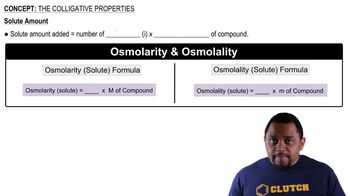Here are the essential concepts you must grasp in order to answer the question correctly.
Colligative Properties
Colligative properties are physical properties of solutions that depend on the number of solute particles in a given amount of solvent, rather than the identity of the solute. These properties include boiling point elevation, freezing point depression, vapor pressure lowering, and osmotic pressure. The extent of boiling point elevation is directly related to the concentration of solute particles, which explains the different effects of HCl and acetic acid when dissolved in water.
Recommended video:
The Colligative Properties Concept 3
Ionization of Solutes
Ionization refers to the process by which a solute dissociates into ions when dissolved in a solvent. HCl is a strong acid that completely ionizes in water to produce two particles: H⁺ and Cl⁻. In contrast, acetic acid is a weak acid that only partially ionizes, resulting in fewer particles in solution. This difference in ionization leads to a greater boiling point elevation for HCl compared to acetic acid.
Recommended video:
Boiling Point Elevation Formula
The boiling point elevation can be calculated using the formula ΔT_b = i * K_b * m, where ΔT_b is the change in boiling point, i is the van 't Hoff factor (number of particles the solute breaks into), K_b is the ebullioscopic constant of the solvent, and m is the molality of the solution. For HCl, i equals 2 due to complete ionization, while for acetic acid, i is less than 2, reflecting its partial ionization. This difference in i directly affects the boiling point increase observed.
Recommended video:
Boiling Point Elevation Concept 1






